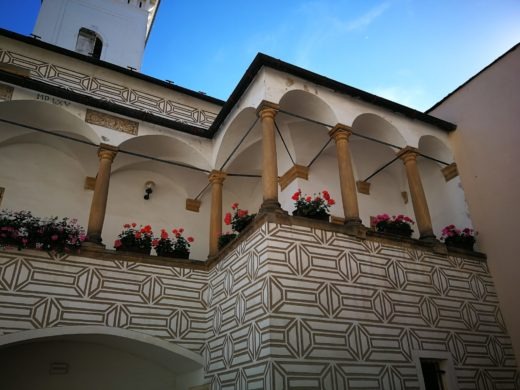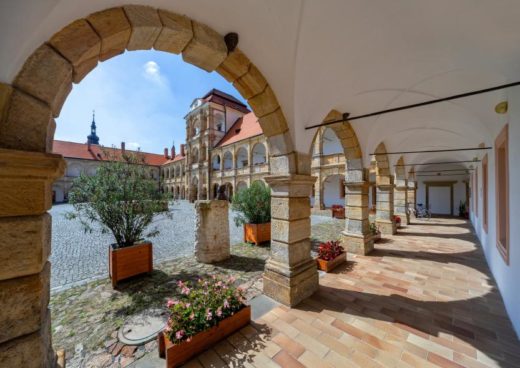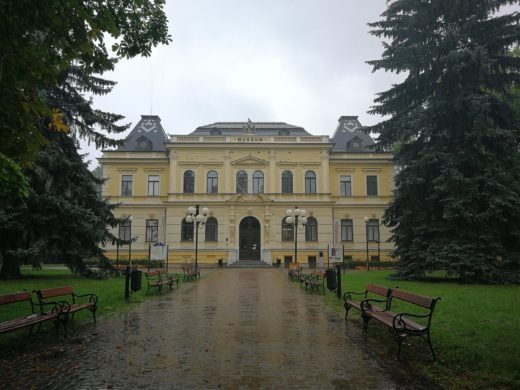There are two kinds of people: those who prefer to spend their free time in busy cities and those who like to slow down a bit in more peaceful places. If you belong to the latter group, you probably won’t enjoy that much cities like Prague, Brno or Ostrava or places crammed with tourists such as Český Krumlov or Lednice-Valtice Cultural Landscape. In that case, small towns such as Moravská Třebová may be perfect for you. It’s a beautiful small town mostly forgotten by Czech and foreign tourists alike. And that’s a big shame.
A Bit About the Town
Moravská Třebová is a small town located almost at the border of Moravia and Bohemia. It has about 9 900 inhabitants and even on busy days, it feels like a permanent Sunday because it’s so peaceful and quiet. That’s at least until you run into two teenagers fighting over a dumpling (knedlík) from a nearby shop. And yes, I actually witnessed that.
The town blossomed especially during the reigns of the lords of Boskovice and Ladislav Velen of Žerotín (who actually wasn’t from Žerotín but from the South Moravian town of Břeclav). That’s mostly when it became the town it is now.
Later, the town was – similarly to Brno – shaped by the textile industry. Unfortunately, most factories eventually went bankrupt.
The Picturesque Square
Once you’re in Moravská Třebová, you must not forget to visit the beautiful Renaissance square. Sure, I mention “beautiful renaissance squares” in almost every article, but the historical centre of Moravská Třebová is actually one of the most intact renaissance squares in the Czech Republic. In fact, the square is so intact and fascinating that the town got the nickname “the Renaissance Pearl of the Czech Republic” because of it. And, mind you, the Czech Republic isn’t actually very rich in intact Renaissance buildings thanks to the religious conflicts of the 15th and 16th century. Only some towns and cities – such as Moravská Třebová and Český Krumlov, for example – are lucky enough to be this unique.
The square is dominated by the Town Hall with a tall tower that happens to be baseless. The original Town Hall was built in the 15th century but it later burned down and had to be rebuilt. Unfortunately, this was not the only time the building or its part burned down – this repeated a few times as if the place was cursed. By the way, the Town Hall has its own mystery – during reconstruction works in 1824 a closed space was found on the 1st floor of the Town Hall. It was not completely empty, though, as skeletal remains of an unknown person in chains were found there. The poor walled up person’s chains were marked with the year 1563. Some think that the person was put in there in order to protect the Town Hall from misfortune because things like this were not unusual. If that’s so, it clearly didn’t work exactly as intended.

Another thing you can see in the square is the Plague Column which was raised after the town was hit by plague in the 18th century.
Not too far from the square, you can also find the Church of the Assumption of the Virgin Mary. It was built in the place of a medieval sanctuary that burned down in the 16th century. Later in the 18th century, the rebuilt church burned down again and was rebuilt by the town’s then-owners, the Liechtenstein family. The restoration was undertaken by the architect A. M. N. Beduzzi, who was the imperial court theatre engineer of Joseph I.
By the way, when walking around the town you can actually see the remnants of the town’s fortification system. So keep your eyes wide open so you don’t accidentally miss it!
The Local Château
Just around the corner from the square, you can find the local château which was built in the place of a 13th-century castle. The castle’s transformation into a Renaissance château was started by Ladislav of Boskovice in the late 15th century. It was the aforementioned Ladislav Velen of Žerotín who continued this transformation throughout the 17th century. He was a perfect example of a Renaissance man – he could speak several languages and hosted many scholars, artists, stonemasons, and alchemists in the château. Besides that, he also supported the publishing activities of the Unity of Brethren, financed a number of cultural activities, and also personally knew J. A. Komenský, who dedicated his famous map of Moravia to him. All this contributed to the fact that Moravská Třebová got the nickname the Moravian Athens. Unfortunately, this era ended with the infamous Battle of the White Mountain because of which Ladislav Velen of Žerotín had to go into exile. After his forced emigration, the château fell into the possession of the Liechtenstein family, who essentially finished the château’s transformation and owned it until 1945 when they were expelled from the country. Nowadays it is considered one of the most important Renaissance buildings in Central Europe.

Křížový vrch – the Hill of Crosses
Maybe you have visited too many châteaus to truly enjoy visiting the one in Moravská Třebová. Or maybe you are too adventurous for that. If so, you might like the Hill of Crosses (Křížový vrch in Czech). Although it’s not exactly a place full of crosses of different sizes as you may imagine, it’s still pretty macabre. Here you can find, for example, the Staircase of the Dead (Schodiště mrtvých) that leads to the local cemetery and was built in the 16th century. Together with the cemetery church of the Finding of St. The Crisis and the morgue it was declared an immovable cultural monument. However, if you’re not a fan of all things macabre, you’ll probably appreciate the Baroque Sculpture of Calvary, which was built in the 18th century at the request of the Prince Josef Jan Adam of Liechtenstein.
The story of the Weeping Anna
The macabre staircase and the Baroque statue are not the only interesting things you can find on the Hill of Crosses. Romantic souls will surely love the vantage point at the Weeping Anna’s. Interested in finding out how the place got its name? It all started in 1818 when a young woman named Anna Glässer met Josef Herkner – a son of Moravská Třebová’s mayor, and they instantly fell in love. You’d probably think that Anna’s parents would approve of such a wealthy suitor but they had previously decided to marry her off to another man and insisted on the end of their relationship. Despite that, the young lovers continued secretly seeing each other and exchanged many letters in which they assured each other of their everlasting love. This lasted until March 1823 when Anna sent Josef her last sad letter. One year later she was forcefully married off to Franz Gromes, a reeve from the village of Linhartice. Before Anna’s marriage, Josef set up a beautiful garden on the slope of the Hill of Crosses from which one could see poor Anna’s new home. Soon after the wedding, Anna got ill and she died of “spitting blood” in 1825 – probably tuberculosis.
She was buried in the Gromes family crypt but the heartbroken Josef re-buried her in a layer of roses and black silk in the garden he had previously set up. Legend has it that year, on 25th July – which is the eve of St. Anna’s Day – the path from the town to the garden was illuminated by torches. Torches were also burning in the garden – around a place that resembles a grave – and the music was playing in the background, which attracted the attention of many people in the town. Is it just a legend? Probably not – only an empty coffin was found in the grave where Anna was originally buried in 1924, and ten years later remains of a young woman were found in the place of Josef’s garden. The remains were buried in a thick layer of flowers and black silk so it was assumed they indeed belonged to Anna Gromes, née Glässer. Anna’s step-granddaughter then requested the body to be returned into its original grave in the Gromes family crypt. A marble plaque was then placed on the grave. It says: “Here rests Anna Gromes, née Glässer. She was buried here on January 25, 1825; re-buried on June 29, 1834. Let love last even for the grave, but let there be peace behind the cemetery wall.”
Anyway, there also used to be a statue of the Weeping Anna which was vandalized in the ’90s. Recently, the town of Moravská Třebová launched a public fund-raising campaign aimed at the restoration of the statue. People donated over 95 thousand crowns and the new statue is supposed to be unveiled later this year.
Other Things to See in the Town
In case you thirst for knowledge, then you should visit the local Museum. Its founding is linked to the local educational association. The association was founded in 1872, and building a museum collection was one of its proclaimed goals from the very beginning. Some of its first exhibits were gifted to the museum by a successful businessman, passionate traveller and a patron, Ludwig Holzmaister, who was born in Moravská Třebová. The building itself was finished in 1906 and inside you can find, for example, a mummy of the Egyptian princes Hereret.
The more adventurous of you can also visit the lookout tower Pastýřka, which is 27 metres tall. It is situated on the Pastvisko hill, and, to all those who manage to climb all the way to its top, it offers a picturesque view of Moravská Třebová as well as the Jeseníky and the Orlice Mountains.

Where to Eat
Unless you’re planning to fight the local teenagers over a dumpling, there are many good places where you can fill your tummy. There are 14 restaurants, cafés and bistros in total. The complete list of restaurants can be found on the town’s website.
If Sunday were a town, it would absolutely be Moravská Třebová. If you like Sundays – and I believe everyone does – don’t hesitate to visit this beautiful town!
If you’re a curious person who likes travelling, keep an eye on our blog to learn more about these interesting places! If you don’t want to check the blog for more tips for trips, just subscribe to our special newsletter or follow us on Facebook and Instagram!

I read your blog and found it interesting. My interest in Trübou sprang from a photos of my husband’s grand mother and her two children taken around 1906 in one of the photographic studios of the town: C. M. Rücher & F. Tack., her name was Franciska Werner married with Joseph Pirak and I only know that the 9th of May 1907 she left Europe to join her husband in Canada.
Hi Maria Teresa,
What an interesting tidbit! Thank you for sharing!
Best,
Tereza